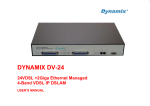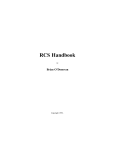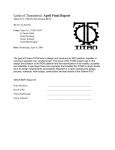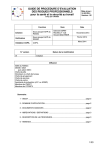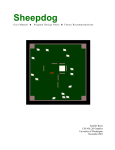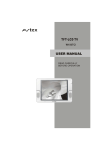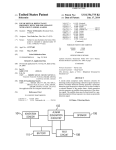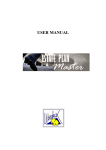Download File - Morgan Shearer Industrial Designer
Transcript
Timothy Tetlow Morgan Shearer Jonny Stelling Mitch Sandhu Contents page Project Sections Overall project Gantt chart Project brief Research & product analysis of existing similar solutions Initial investigation Specification Concept ideas & annotations Review & evaluate concepts Group evaluation of initial concepts ideas & development Final concept Engineering & final concept drawings Posters User Manual Mass Manufacturing Other uses for product Concept Evaluation – Improvements Page Nos Gantt chart Project Brief CONTEXT Users can be a source of inspiration for designers simple techniques can be used such as: Triggering the user (what prompt people to use the product), interacting with the user’s environment (optimising the product fit into the user context), promoting user customisation (are users redesigning or changing the product), understanding the intangible attributes of the product (the non obvious attributes that are key in the user perception of the product i.e. the smell of new in cars), observing the unarticulated user needs (problems that users don’t know can be solved). Not all users can however be relied upon as a source of inspiration, indeed, old customers/users have their legacies (infrastructures, ways of doing business...), design needs the new users with their new requirements and demands. Even amongst new users, finding inspiration can be a challenging task. Who are theses design-inspiring users? Contrary to ordinary users, who have good usage experience but not necessarily good technological knowledge, these inspiring users are the leading edge ones at the forefront of usage. Design-inspiring users have needs and wants that are representative of the majority of the users. They combine a good usage experience with a good technological knowledge, and are thus ahead of technical experts who do not have usage experience. Extreme users, i.e. obsessive amateurs, on the other hand, are in fact amateur designers, that can translate their ideas into workable prototypes. Ask users what do they want to achieve with the product rather than what features they would like it to have! ASSIGNMENT The objective of this project is to design artefacts that solve a problem from the user’s perspective. Addressing his/her need(s) clearly and effectively. The device should be credible and as such not constrain the user nor hinder him/her. Ideally you will have identified an issue and you will design an artifact to solve it as show in the previous photos. You will develop a prototype that need to be at least partially functional and fulfill the same purposes as a final product (i.e. function). You will need to demonstrate development in the following competencies: Ideas & Originality: Concepts, Models, Presentations Usability & Usefulness: Storyboard, Scenario Design Communication: Deliverables, Presentations Design Method: Work progress (what and why) Self Assessment: A short criticism of your work Reference: http://bsalem.info/Teaching/TDP_usercd.html Project Brief Jack who lives in Manor Bank came to us with a problem that he had created a solution for, he wanted a way to know when someone opened his cupboard to prevent anything been stolen from his cupboard. He then cello taped a button to the hob vents, so when his cupboard was opened the button would sound and he would be alerted. He told us that the solution he has created could still be improved, because he has no way of knowing if anything had been stolen from his cupboard if he was outside of the building. He suggested to us that he prefer for some kind of way to be able to lock his cupboard so he would know nothing could be stolen from his cupboard, but he also suggested that he would prefer for the device to be hidden so that it would prevent the lock been tampered with. Research & product analysis of existing similar solutions From our research we had found that there was no hidden locks for cupboards available on the market, there was only lockable clamps or a lock and key types of devices available. We then started researching different types of materials that we could use to make the cupboard lock from, we needed materials that were strong, durable and also water resistant because of the kitchen environment that it would be in (such as steam, water and other liquids). From research we had gathered that we need a materials such as steel (Coated in a protective paint) or stainless steel and PVC because they would be strong, durable and water resistant. References for images: http://www.pambaboma.com/2013/07/kitchen-cabinets-and-child-safety/ http://www.ironmongerydirect.co.uk/products/locks_latches_and_security/budget_and_cabinet_locks/12735/1_lever_straight_cupboard_lock_brass http://24hourlocksmith.com.au/cabinet_locks.htm How will the lock and alarm system look in its surrounding environment? What colours and materials will best suit the design if any is chosen? How important is the aesthetics? What shapes will be involved in the design? What surface finished should be applied, which are suitable for the alarm and the conditions it will face? Functionality Door Lock Environment What is more important the strength of the locking mechanisms or the complexity; is there a way of incorporating both aspects? How should the mechanism lock? Allowing it be a quick and efficient process. Aesthetics How much of the surrounding space will be taken up, by the lock? How is the locking mechanism powered? Ergonomics Does the design affect the safety of others which may be using the surrounding area?? Who will be affected by the product and how will you deter them from changing the effectiveness of the lock? Cost If the materials are expensive how will you make a profit from selling it? Are the materials being used cheap to buy? So that it the lock comes under any damage, it’ll be cheap to pay to repair and replace. Consumer What is being protected by the lock and how will it affect the complexity of the design? How is the style of the locking system going to appeal to the consumers? How efficiently is the process of opening and closing the cupboard? What is the maximum area that the lock can take up without affecting the space within the cupboard? What materials don't get damaged easily and are lightweight? Initial Specification We have not yet figured out the potential issues and necessary requirements for , to do so a specification is needed. This will outline the issues and will help overcome them. I shall do this by highlighting the major parts of my project, and then state how they are relevant to my product. Relative Authority to be Consulted In my project I have to take into consideration the appropriate authorities before putting the locking system into production, companies like the British Standards institute. The lock must fit the guidelines of the BSI and will hopefully achieve the BSI kite emblem. The kite it known worldwide and is a symbol of trust, integrity and quality. If the lock is of a high enough standard to achieve the kite, then the sales of my product might rise. Performance It must perform at a high enough standard to gain a good reputation by the people using it. The locking mechanism must be strong enough to handle any forceful attempts of entry into the cupboard. It also should only be able to only accept the unique combination, card or key of the owner; therefore the lock can’t be tampered with. Must be easy to lock and unlock when necessary, minimising the time of the user. For the product to be a success it should reach the demands of the public; allowing the users products to be safe when using the locking mechanism. Ergonomics/Anthropometrics Locking mechanism must be the right size so that it can work well with the user; small enough to be discrete and not take too much of the cupboard space however big enough to give access to the key easily. If a handle is involved in the mechanism; the handle must be comfortable in the users hand and fit the correct shape and size. Maintenance Depending on the locking system, it may need to be oiled on a regular basis to keep mechanisms moving smoothly and keeping the possibility of rust to a minimum, if the product rusts it will also weaken the joints, making it more liable to damage. However this shouldn’t be a major issue because the joints shouldn’t be exposed. If magnetic or electrical locks are being used, the power source has to be considered. If the lock is powered using an electrical main the fuse within the product may needed to be changed. However if it’s powered using batteries; the batteries will needed to be changed regularly and the position of the batteries needed to be taken into consideration. If bulbs are used, they may need to be changed depends on there size; however LED lights are the most suitable as they last longer, much more durable and are cheap. Aesthetics Although it isn’t a priority the lock must be of a certain standard, so that the general public will be attracted to it over other product. Product should look modern and different, reengineering the idea of a lock; giving the product its own innovative design and standing out from the rest of the market. Making it distinct and perhaps appealing to more people within the market. Materials/Components The product can be made from a range of materials product; such as a polished metal, polymer or a much more subtle material like wood. When considering the casing of the material certain things need to be considered when developing the functionality of the lock such as strength to weight ratio and durability. For instance mild steel is very strong; however it would weigh a lot, possibly damaging the material the lock is attached too. If possible a combination of materials will be used adding to the aesthetics. However this isn't very important for a lock, so it will be taken into account once the main issues have been resolved. Components within the product must also be considered, as they have to be durable and be able to cope with any attempts at forceful entries. Production The initial prototype should be the same quality as the final product; this will give a clear understanding of the most suitable production method for the locks size and shape. Creating a prototype will clearly showing the most efficient method as well as improvements which could be made to the system. Safety The corners and edges of the lock should be curved or blunt, so that when it comes into contact with the users it keeps the possibility of injury to a minimum. Any electrical parts should be hidden inside of casing, stopping people from being electrocuted by any faulty wiring. If lights are used to show whether the door is unlocked or not; they shouldn’t be too bright to hurt the eyes however bright enough to be seen easily. Because the lock is made of multiple parts, joining method must be done to a high standard so that the product is smooth and doesn’t have any lose pieces. Cost The product must be made to a high standard; however it must still be made of cheap enough materials for a suitable budget. If my product ends up being created in mass use, the materials must be cheaper so that it is easy to create and sell. My product would be sold for £10-£30. The ranges between these prices are high, because the price of materials changes and the price from the manufactures creating the components will change over time as well as improvements of the technology within the product. Testing A range of tests will needed to be carried out on the prototype to check that it is of a suitable standard. This will test if my product stands up properly compared to the other locks within its target market. Initially the tests will be based on safety; checking that the electrics, mechanisms and corners are finished to a high standard, this will help to decide whether the product is safe to use. Secondly functionality must be tested; making sure its simple to use however effective at completing its job. The final test will be a questionnaire to see if the lock is aesthetically pleasing. Relative Authority to be Consulted In my project I have to take into consideration the appropriate authorities before putting the locking system into production, companies like the British Standards institute. The lock must fit the guidelines of the BSI and will hopefully achieve the BSI kite emblem. The kite it known worldwide and is a symbol of trust, integrity and quality. If the lock is of a high enough standard to achieve the kite, then the sales of my product might rise. Performance It must perform at a high enough standard to gain a good reputation by the people using it. The locking mechanism must be strong enough to handle any forceful attempts of entry into the cupboard. It also should only be able to only accept the unique combination, card or key of the owner; therefore the lock can’t be tampered with. Must be easy to lock and unlock when necessary, minimising the time of the user. For the product to be a success it should reach the demands of the public; allowing the users products to be safe when using the locking mechanism. Ergonomics/Anthropometrics Locking mechanism must be the right size so that it can work well with the user; small enough to be discrete and not take too much of the cupboard space however big enough to give access to the key easily. If a handle is involved in the mechanism; the handle must be comfortable in the users hand and fit the correct shape and size. Maintenance Depending on the locking system, it may need to be oiled on a regular basis to keep mechanisms moving smoothly and keeping the possibility of rust to a minimum, if the product rusts it will also weaken the joints, making it more liable to damage. However this shouldn’t be a major issue because the joints shouldn’t be exposed. If magnetic or electrical locks are being used, the power source has to be considered. If the lock is powered using an electrical main the fuse within the product may needed to be changed. However if it’s powered using batteries; the batteries will needed to be changed regularly and the position of the batteries needed to be taken into consideration. If bulbs are used, they may need to be changed depends on there size; however LED lights are the most suitable as they last longer, much more durable and are cheap. Aesthetics Although it isn’t a priority the lock must be of a certain standard, so that the general public will be attracted to it over other product. Product should look modern and different, reengineering the idea of a lock; giving the product its own innovative design and standing out from the rest of the market. Making it distinct and perhaps appealing to more people within the market. Relative Authority to be Consulted This design will be manufactured using suitable mass or batch production techniques, such as lathing through use of CAD/CAM or die casting, as well as use high quality materials from organisations holding the BSI Kite symbol too. To make sure the product is produced to suitable standards regular quality check will have to be done to make sure the finished product meets the high standards of the BSI and that of our customers. Performance The bracket and key of the lock be made from steel so durability should not be an issue there. The bolt of the lock will be made from aluminium which will be suitably durable for an relatively mild indoor environment. The bolt on this design will be flush with the bottom surface of the cupboard so unable to move except by the use of the special key the comes with it. This unique key has an awkward shape unlike any you would normally find about an everyday household so as to make it difficult to gain entry by using other tools. The flush surface means that it will be nearly impossible to move the bolt without causing obvious signs of tampering especially since the bolt will be made out of aluminium for this exact purpose so that if anyone were to tamper with the bolt, obvious scratch marks would appear alerting the user/ owner of the cupboard. Ergonomics/Anthropometrics The locking mechanism is small and discrete but thanks to the key which will work nicely as an extra to a key chain it will also be easy to operate, the key giving the user the sufficient leverage and grasp to operate the system easily and effectively whilst not being too obvious when in use. Maintenance There is no need for maintenance as this is a very simple design consisting of 3 components; a bolt, a bracket and a key none of which should ever need maintenance unless tampering occurs or accidental damage, depending on how severe the lock may need to be replaced. Aesthetics This is a hidden design so there will be no outside aesthetics, once inside the cupboard there will be a bracket attached to the door of the cupboard and the top of the bolt protruding from the base however aesthetics will still not feature a major role. The fine finish of the aluminium and steel should add a little to the aesthetics however it will still not be a main focus of this design. Materials/Components The product can be made from a range of materials product; such as a polished metal, polymer or a much more subtle material like wood. When considering the casing of the material certain things need to be considered when developing the functionality of the lock such as strength to weight ratio and durability. For instance mild steel is very strong; however it would weigh a lot, possibly damaging the material the lock is attached too. If possible a combination of materials will be used adding to the aesthetics. However this isn't very important for a lock, so it will be taken into account once the main issues have been resolved. Components within the product must also be considered, as they have to be durable and be able to cope with any attempts at forceful entries. Materials/Components The Bracket will be made of thin sheets of steel, since they are only thin sheets then weight will not be an issue however it will need to be strong which is why I believe steel to be a suitable material for this component. The same applies to the Key, parts will be thin and delicate if made of weaker materials therefore steel will also be appropriate here since this is also a small component. The bolt needs to be strong but I have chosen to make it out of aluminium as it is a much softer material than steel and would show up any signs of forced entry/ tampering quite clearly whilst also being strong enough to hold any potential thieves at bay. Production The initial prototype should be the same quality as the final product; this will give a clear understanding of the most suitable production method for the locks size and shape. Creating a prototype will clearly showing the most efficient method as well as improvements which could be made to the system. Production I believe die casting will be most suitable for bolt and key whilst stamping will be more efficient for the bracket, the bracket, since it is a common and simple component could even be ordered in in bulk from an outside company saving on production and set up costs. Safety The corners and edges of the lock should be curved or blunt, so that when it comes into contact with the users it keeps the possibility of injury to a minimum. Any electrical parts should be hidden inside of casing, stopping people from being electrocuted by any faulty wiring. If lights are used to show whether the door is unlocked or not; they shouldn’t be too bright to hurt the eyes however bright enough to be seen easily. Because the lock is made of multiple parts, joining method must be done to a high standard so that the product is smooth and doesn’t have any lose pieces. Safety The bracket has curved edges to prevent any accidental cut or scraps. The key has a cap to protect the key as well as the user from potential damage or harm. The Bolt has curved edges and is flush with the underside of the cupboard. There are no sharp corners upon which a user may accidentally hurt themselves. Cost The product must be made to a high standard; however it must still be made of cheap enough materials for a suitable budget. If my product ends up being created in mass use, the materials must be cheaper so that it is easy to create and sell. My product would be sold for £10-£30. The ranges between these prices are high, because the price of materials changes and the price from the manufactures creating the components will change over time as well as improvements of the technology within the product. Testing A range of tests will needed to be carried out on the prototype to check that it is of a suitable standard. This will test if my product stands up properly compared to the other locks within its target market. Initially the tests will be based on safety; checking that the electrics, mechanisms and corners are finished to a high standard, this will help to decide whether the product is safe to use. Secondly functionality must be tested; making sure its simple to use however effective at completing its job. The final test will be a questionnaire to see if the lock is aesthetically pleasing. Cost The initial set up costs would be high to set up the processes for the manufacture of the bolt and key but the brackets can be ordered in in bulk saving on set up and production cost. Once up and running the total cost per unit should be no more than £5 to produce meaning the locking system can then be sold on at a fairly cheap price allowing it to keep up with other locking system designs. Testing I believe the best way to test this idea would be to first test each components individual strength and see where, if any, the weaknesses lie. Then to place a £5 note inside and ask someone to open the cupboard, if they can open it without showing any obvious signs of tampering, whilst using a selection of tools found about the house we provide, they can keep the £5 note. Model Relative Authority to be Consulted In my project I have to take into consideration the appropriate authorities before putting the locking system into production, companies like the British Standards institute. The lock must fit the guidelines of the BSI and will hopefully achieve the BSI kite emblem. The kite it known worldwide and is a symbol of trust, integrity and quality. If the lock is of a high enough standard to achieve the kite, then the sales of my product might rise. Performance It must perform at a high enough standard to gain a good reputation by the people using it. The locking mechanism must be strong enough to handle any forceful attempts of entry into the cupboard. It also should only be able to only accept the unique combination, card or key of the owner; therefore the lock can’t be tampered with. Must be easy to lock and unlock when necessary, minimising the time of the user. For the product to be a success it should reach the demands of the public; allowing the users products to be safe when using the locking mechanism. Ergonomics/Anthropometrics Locking mechanism must be the right size so that it can work well with the user; small enough to be discrete and not take too much of the cupboard space however big enough to give access to the key easily. If a handle is involved in the mechanism; the handle must be comfortable in the users hand and fit the correct shape and size. Maintenance Depending on the locking system, it may need to be oiled on a regular basis to keep mechanisms moving smoothly and keeping the possibility of rust to a minimum, if the product rusts it will also weaken the joints, making it more liable to damage. However this shouldn’t be a major issue because the joints shouldn’t be exposed. If magnetic or electrical locks are being used, the power source has to be considered. If the lock is powered using an electrical main the fuse within the product may needed to be changed. However if it’s powered using batteries; the batteries will needed to be changed regularly and the position of the batteries needed to be taken into consideration. If bulbs are used, they may need to be changed depends on there size; however LED lights are the most suitable as they last longer, much more durable and are cheap. Aesthetics Although it isn’t a priority the lock must be of a certain standard, so that the general public will be attracted to it over other product. Product should look modern and different, reengineering the idea of a lock; giving the product its own innovative design and standing out from the rest of the market. Making it distinct and perhaps appealing to more people within the market. Relative Authority to be Consulted Our design will be manufactured using suitable ‘one off’ production techniques because it is been designed for our chosen user, techniques such as CAD/CAM to produce the handle, supporting bracket, locking bracket, locking arm and custom locking washer. Another technique that will be used will be injection moulding; this will be used to produce the casing of the product. Other parts that are required such as the screws, bolts, washer and spring will be bought in, this is because it will be easier and more economically viable compared to manufacturing the parts ourselves because of the high start-up costs that are involved e.g. machinery, equipment and trained employees. As well as using high quality materials for our design, we will also implement key quality checks throughout the manufacturing process to ensure that the final product meets all of the suitable standards of BSI, so it will hopefully achieve the BSI kite emblem, thus increasing turnover due to the high quality of the product. Performance The handle, screws, bolts, locking bracket and locking arm will all be made from stainless steel to ensure that the product doesn’t rust due to the grease, liquids, steam etc… that can be found in kitchens through the air and also through the user e.g. as the user interacts with the product, if any grease or liquids are found on their hands this could cause the product to rust if the metal isn’t protected. The design will include two supporting brackets that will be located in both of the corners at the top of the cupboard door, this will help prevent the design from causing any stress to the hinges which could damage them, on the cupboard because of the interactions of the user with the product requiring them to pull the handle upwards to unlock and allow them entry to the cupboard. The design is simple, time effective and safe, only requiring the user to simply pull the handle upwards to unlock the cupboard, requiring a minimal amount of time to unlock, doesn’t require them to use a key to unlock it and is safe to use due to the fact that the locking mechanism in encased by a plastic case and the locking arm, locking bracket and handle don’t have any sharp edges that could injure the user. The design also automatically locks because of the spring been attached to the custom locking washer, so once the user and pulled the handle upwards it will then automatically return to its original position. If any other people apart from the user try to gain entry to the cupboard without knowing how to unlock it, it will be impossible to unlock it e.g. using a crowbar. If an attempt is made at forcing entry to the cupboard, the marks left by the forced entry will alert the user that someone has tampered with the cupboard and product. Ergonomics/Anthropometrics The locking mechanism is small, discrete and is partly enclosed within a plastic casing and doesn’t take up a huge amount of space within the cupboard. The handle in the design is comfortable for the user to hold and fit in their hand due to the handle been smooth and doesn’t include any sharp edges that could cause the user any discomfort or injury. The product when installed will be unnoticeable, apart from the slightly bigger handle mounts. Maintenance Due to the fact that the parts of our product will be made from metal will be created using stainless steel eliminates the potential that the product could rust, so the product can’t be weakened by the environment that it will be implemented into. Yearly maintenance includes removing the case and bracket by undoing the screws, and re greasing the moving washers that are found underneath the bolts attached to the bracket, because over time the grease can begin to disappear from the areas that it has been applied to and not allow the handle to move up and down smoothly. Every 2-5 years involves removing the case and bracket by undoing the screws then checking the spring to see if it needs to be replaced, because overtime the spring can become less effective and not return to its original shape. If our product is correctly maintained we give it a life expectancy of 7-10 years. Aesthetics Our design is hidden inside the cupboard apart from the redesigned handle that will be included in our design. The only aesthetic changes to the handle are that it has slightly longer mounted bases to cover up the holes that need to be cut in the door to allow for the handle to move up and down. Our product looks modern due to the handle been made from stainless steel and it is an innovative idea standing out from handle cupboard locks that are available on the market. Materials/Components The product can be made from a range of materials product; such as a polished metal, polymer or a much more subtle material like wood. When considering the casing of the material certain things need to be considered when developing the functionality of the lock such as strength to weight ratio and durability. For instance mild steel is very strong; however it would weigh a lot, possibly damaging the material the lock is attached too. If possible a combination of materials will be used adding to the aesthetics. However this isn't very important for a lock, so it will be taken into account once the main issues have been resolved. Components within the product must also be considered, as they have to be durable and be able to cope with any attempts at forceful entries. Production The initial prototype should be the same quality as the final product; this will give a clear understanding of the most suitable production method for the locks size and shape. Creating a prototype will clearly showing the most efficient method as well as improvements which could be made to the system. Safety The corners and edges of the lock should be curved or blunt, so that when it comes into contact with the users it keeps the possibility of injury to a minimum. Any electrical parts should be hidden inside of casing, stopping people from being electrocuted by any faulty wiring. If lights are used to show whether the door is unlocked or not; they shouldn’t be too bright to hurt the eyes however bright enough to be seen easily. Because the lock is made of multiple parts, joining method must be done to a high standard so that the product is smooth and doesn’t have any lose pieces. Cost The product must be made to a high standard; however it must still be made of cheap enough materials for a suitable budget. If my product ends up being created in mass use, the materials must be cheaper so that it is easy to create and sell. My product would be sold for £10-£30. The ranges between these prices are high, because the price of materials changes and the price from the manufactures creating the components will change over time as well as improvements of the technology within the product. Testing A range of tests will needed to be carried out on the prototype to check that it is of a suitable standard. This will test if my product stands up properly compared to the other locks within its target market. Initially the tests will be based on safety; checking that the electrics, mechanisms and corners are finished to a high standard, this will help to decide whether the product is safe to use. Secondly functionality must be tested; making sure its simple to use however effective at completing its job. The final test will be a questionnaire to see if the lock is aesthetically pleasing. Materials/Components The bracket, locking bracket, locking arm and custom locking washer will be made from thin sheets of stainless steel, this will mean that they are lightweight but also strong enough to withstand any attempts of forced entry. The plastic casing could be made from polypropylene because it is a tough material with good tensile strength and inertness toward acids, alkalis and solvents; it also has a very low density and is light weight. It is commonly found in toys and household goods. Another plastic material that we could use to make our casing could be PVC because it is durable, long lasting material that comes in rigid states, it is also has inherent flame retardant, and chemical resistant. These two materials are perfect to use to make a case for our design, and they can both be made by using an injection moulding machine. Other parts that are required such as the screws, bolts, washer and spring will be bought in, this is because it will be easier and more economically viable compared to manufacturing the parts ourselves because of the high start-up costs that are involved e.g. machinery, equipment and trained employees. They will all still be made from stainless steel to prevent them from rusting and still retain strength to prevent anyone forcing entry to the cupboard. Using stainless steel, PVC/Polypropylene are all durable enough to meet our life expectancy for the product. Production To manufacture our design we will use the following techniques; to manufacture the parts that are made from stainless steel CAD/CAM manufacturing technique will be used because this process (although more expensive compared to other manufacturing techniques) gives a higher level of precision and accuracy compared to other manufacturing methods. To manufacture the parts that are made from plastic such as the casing, injection moulding manufacturing technique because (although potentially more expensive compared to other manufacturing techniques) it gives a greater accuracy and more variation compared to other manufacturing techniques, and also allows me to manufacture the shell using the chosen type of plastic. Safety All the component parts in our design will have curved edges to prevent any potential harm to the user e.g. cuts, scratches etc… All of the locking mechanism will be covered by the plastic case so the user can’t harm themselves. The design doesn’t require the user to put any limbs near any areas which could potentially trap them e.g. trapped fingers. The product will be secure once it has been installed apart from the moveable handle, so this will eliminate any harm to the user. Cost Our product will be made from high quality materials such as stainless steel and PVC/Polypropylene, and we estimate the product to cost between £20-£30 to be made as a ‘one off’’ product. If mass production was to be used, we estimate each individual product to cost between £5-£13 to be made, which would provide a significant saving to production costs due to materials and parts to be bought in at a much cheaper price and because of the machining costs been reduced because of higher volumes. Testing The first test that we would carry out on our product would be to test the safety of the product and whether anything could hurt the user or anyone else within the vicinity, things such as sharp edges and places where limbs could potentially get trapped etc… The second test that we would carry out would on our product would be to install it into its environment, then ask the members of the flat whether they can see any change in the kitchen within a day. This test will help find out how effectively the product has been hidden and if it is noticeable. The third test that we would carry out on our product would be to install it onto a cupboard and give each member of the flat 10 minutes to try and open the cupboard without showing any obvious signs of tampering on the cupboard. This test would tell us how effective our locking design is, whether it is strong or weak, and also how difficult it is for other people/’s to unlock the cupboard without been told the correct way to open it. The final test would be to ask each member of the flat to complete a questionnaire about our product to see whether it is aesthetically pleasing, this would help tell us whether we have created an aesthetically pleasing product. Relative Authority to be Consulted In my project I have to take into consideration the appropriate authorities before putting the locking system into production, companies like the British Standards institute. The lock must fit the guidelines of the BSI and will hopefully achieve the BSI kite emblem. The kite it known worldwide and is a symbol of trust, integrity and quality. If the lock is of a high enough standard to achieve the kite, then the sales of my product might rise. Performance It must perform at a high enough standard to gain a good reputation by the people using it. The locking mechanism must be strong enough to handle any forceful attempts of entry into the cupboard. It also should only be able to only accept the unique combination, card or key of the owner; therefore the lock can’t be tampered with. Must be easy to lock and unlock when necessary, minimising the time of the user. For the product to be a success it should reach the demands of the public; allowing the users products to be safe when using the locking mechanism. Ergonomics/Anthropometrics Locking mechanism must be the right size so that it can work well with the user; small enough to be discrete and not take too much of the cupboard space however big enough to give access to the key easily. If a handle is involved in the mechanism; the handle must be comfortable in the users hand and fit the correct shape and size. Maintenance Depending on the locking system, it may need to be oiled on a regular basis to keep mechanisms moving smoothly and keeping the possibility of rust to a minimum, if the product rusts it will also weaken the joints, making it more liable to damage. However this shouldn’t be a major issue because the joints shouldn’t be exposed. If magnetic or electrical locks are being used, the power source has to be considered. If the lock is powered using an electrical main the fuse within the product may needed to be changed. However if it’s powered using batteries; the batteries will needed to be changed regularly and the position of the batteries needed to be taken into consideration. If bulbs are used, they may need to be changed depends on there size; however LED lights are the most suitable as they last longer, much more durable and are cheap. Aesthetics Although it isn’t a priority the lock must be of a certain standard, so that the general public will be attracted to it over other product. Product should look modern and different, reengineering the idea of a lock; giving the product its own innovative design and standing out from the rest of the market. Making it distinct and perhaps appealing to more people within the market. Relative Authority to be consulted If the design were to go to market, it would be manufactured using mass or batch production, this is due to the fact that it would be more cost effective to use this manufacturing process as if the lock was to be made using ‘one off’ manufacture then the manufacturing costs of the product would go up dramatically meaning that the product would be out of the price range for its intend target market. The lock would be made using mostly CNC millers / lathes as well as the use of formers to push and shape the metal components into shape. This use of automated manufacture also helps to insure that the product meets stringent quality and control measures. Performance The lock would perform quite well in its intended location due to the fact that it would be extremely easy to use, as it only involves the user inserting a uniquely shaped key into the barrel of the lock and pushing it to unlock the intended door. It also has additional features which help insure that no unauthorised access can occur. There are unique grooves placed upon the key and they would match up with bumps and grooves within the barrel of the lock. This means that the lock will not open unless all of these grooves are in place. Another added layer of security is that the plus key has a slightly longer edge on one of its points meaning that the key will only fit into the lock one way round. This means that if somebody were to find the key they would then have to know about this additional security feature. Also the locking mechanism has been designed to withstand any tampering and forced entry as when the door is locked the leaver mechanism is firmly locked in place. This means that the harder you try to pull the more secure the lock will become. I think this is the products most appealing and interesting feature. Ergonomics Ergonomics was not a large part of the design as most of the lock system is permanently situated within the door. Yet my key is slightly ergonomic in the fact that is small enough to fit into the palm of your hand and is not to large that it would become an inconvenience to use. It is also just the right size to fit in your hand easily when unlocking the lock. Maintenance There would be very little maintenance required for the use of the product as the lock is made from a range of strong lightweight materials meaning that the lock and key would last for a long time with next to no maintenance required. This would be a good selling point for the product as people live to purchase products which are durable and long lasting. The only maintenance the user would have to do is lubricate the internal workings of the lock every once in a while to help it insure that the product has a long life span. Aesthetics The lock has been designed to be extremely aesthetically pleasing. This is down to a number of things like the material that it is made from, the design and shape of the product and in the way it has been finished in the manufacturing process. Due to the fact that the product is made from high grade aluminium witch leaves a matt look which would help the system fit into most modern looking kitchens; adding to the overall aesthetics of the product Materials/Components The product can be made from a range of materials product; such as a polished metal, polymer or a much more subtle material like wood. When considering the casing of the material certain things need to be considered when developing the functionality of the lock such as strength to weight ratio and durability. For instance mild steel is very strong; however it would weigh a lot, possibly damaging the material the lock is attached too. If possible a combination of materials will be used adding to the aesthetics. However this isn't very important for a lock, so it will be taken into account once the main issues have been resolved. Components within the product must also be considered, as they have to be durable and be able to cope with any attempts at forceful entries. Production The initial prototype should be the same quality as the final product; this will give a clear understanding of the most suitable production method for the locks size and shape. Creating a prototype will clearly showing the most efficient method as well as improvements which could be made to the system. Safety The corners and edges of the lock should be curved or blunt, so that when it comes into contact with the users it keeps the possibility of injury to a minimum. Any electrical parts should be hidden inside of casing, stopping people from being electrocuted by any faulty wiring. If lights are used to show whether the door is unlocked or not; they shouldn’t be too bright to hurt the eyes however bright enough to be seen easily. Because the lock is made of multiple parts, joining method must be done to a high standard so that the product is smooth and doesn’t have any lose pieces. Cost The product must be made to a high standard; however it must still be made of cheap enough materials for a suitable budget. If my product ends up being created in mass use, the materials must be cheaper so that it is easy to create and sell. My product would be sold for £10-£30. The ranges between these prices are high, because the price of materials changes and the price from the manufactures creating the components will change over time as well as improvements of the technology within the product. Testing A range of tests will needed to be carried out on the prototype to check that it is of a suitable standard. This will test if my product stands up properly compared to the other locks within its target market. Initially the tests will be based on safety; checking that the electrics, mechanisms and corners are finished to a high standard, this will help to decide whether the product is safe to use. Secondly functionality must be tested; making sure its simple to use however effective at completing its job. The final test will be a questionnaire to see if the lock is aesthetically pleasing. Materials/Components The lock system will be made from high grade aluminium with a brushed finish helping it to fit in with the look and feel of most modern homes. It also helps to increase the overall life span of the product as the better the quality of materials used in the manufacture of a product, the longer the overall life span of the product would help to increase the appeal of the product to potential customers who are wanting to use the product in there student housing. Production This lock will be made using mass or batch production in an automated setting; this would help to keep costs down as well as using fast and accurate manufacturing techniques like CNC lathe work and milling along with the use of cold formers. Testing The best way of testing the unique door lock concept would be to firstly create a one off prototype which could be tested in multiple ways in a controlled environment to help understand the pros and cons of the lock and where if I was to develop the lock could I do so to make it cheap as well as being strong and robust. Safety There aren’t many safety aspects involved with the product as most of the parts are situated within the door its self and any outer parts are small enough not do any real injury if anything were to happen. Cost We plan on keeping the cost down as the target market for the product is for students. This means that we have to create a product that is relatively cheap to make yet does its job well, as a student would not buy a cupboard lock without being sure that it would work. Concept Development After a group discussion we decided to take Concept 2 forward for our final concept because we all felt it was the concept that met the specification the best One of the parts we decided to develop was the locking bracket. We chose this part because we thought we could make the part: more simple to make, therefore reducing manufacturing costs safer by having smooth corners, so the user doesn’t injure themselves using the product After Before Final Concept Final Concept Final Concept Final Concept Final Concept Prototype Engineering & final concept drawings Engineering & final concept drawings Engineering & final concept drawings Engineering & final concept drawings Engineering & final concept drawings Engineering & final concept drawings Engineering & final concept drawings Engineering & final concept drawings Engineering & final concept drawings Engineering & final concept drawings Posters This Poster will also be used to package our product Posters Posters User Manual User Manual User Manual User Manual User Manual User Manual Mass Manufacturing- Customised Handles Below are some customisable handles that could be available if we took our concept into mass manufacturing, so it would be suitable in different environments Mass Manufacturing- Customised Handles Mass Manufacturing- Customised Handles Mass Manufacturing- Customised Handles Mass Manufacturing- Customised Handles Mass Manufacturing- Customised Handles Other uses for product Other uses for product could include been used within environments such as hospitals and bathrooms/toilets where it is vital that workplaces are kept clean and safe at all times, our product can help keep cupboards closed from items such as medicine and chemicals from falling from them which could happen from vibrations within the environment or the items which have been incorrectly stored, which could instantly cause a hazards such as chemical hazards and trip/slip hazards. Another environment where the product could be used could be a domestic environment to protect children from harming themselves. Items such as cleaning equipment which can be in reach for children can be potentially very dangerous to them if they come into contact with them. Our product can stop the storage cupboards from been unlocked by children, preventing any harm to children. Environments where machinery and equipment are stored are a potential trip hazard and also a falling hazard which could cause potential injuries to employees and other people/s within the environment; our product can eliminate any potential hazards that could be caused by items falling from the storage cupboards. Image references: http://quercuscalliprinos.blogspot.co.uk/2011/07/im-sinner-i-take-cross.html , http://www.davidbaileyfurniture.co.uk/queen_alexandra_hospital.htm , http://au.lifestyle.yahoo.com/general/galleries/photo/-/17270468/unexpected-items-you-can-use-as-storage/17270476/ , http://simplyorganizedhomemaking.blogspot.co.uk/ Concept Evaluation – Improvements Possible improvements that we could make to our product could be adding Nylon washers beneath the Stainless steel washers that are already in place. Having this addition to our product would mean that the product wouldn’t need to have yearly maintenance to lubricate the sliding parts because Nylon is a material that is self-lubricating, they are relevantly cheap to buy are would save time for the users once it in place. Combining it with the Stainless steel washers give not only the advantage of having self-lubricating sliding parts, but they would still remain strong and effective if ever the cupboard was tampered with. Image reference: http://www.comdir.co.uk/Products.aspx/iwxnqbeypm/
























































